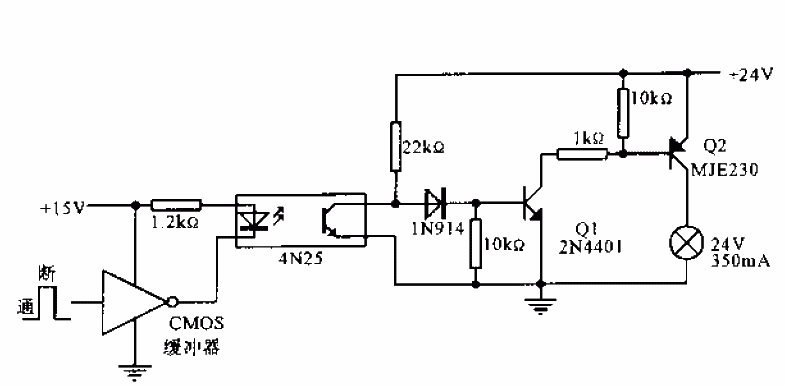CMOS interface circuit
Source: InternetPublisher:走马观花 Keywords: Switching circuit power supply and other power supply circuits Updated: 2020/04/10
Optocoupler (optical coupler, English abbreviation OC) is also called optical coupler, or optocoupler for short. Optocouplers use light as a medium to transmit electrical signals. It has good isolation effect on input and output electrical signals, so it is widely used in various circuits. At present, it has become one of the most diverse and widely used optoelectronic devices. Optocouplers generally consist of three parts: light emission, light reception and signal amplification. The input electrical signal drives the light-emitting diode (LED) to emit light of a certain wavelength, which is received by the photodetector to generate a photocurrent, which is further amplified and output. This completes the conversion of electricity-optical-electricity, thereby playing the role of input, output, and isolation. Since the input and output of the optocoupler are isolated from each other and the electrical signal transmission is unidirectional, it has good electrical insulation and anti-interference capabilities. And because the input end of the optocoupler is a low-resistance component that works in the current mode, it has strong common-mode suppression capabilities. Therefore, it can greatly improve the signal-to-noise ratio as a terminal isolation component in long-term transmission of information. As an interface device for signal isolation in computer digital communications and real-time control, it can greatly increase the reliability of computer work. The main advantages of the optocoupler are: one-way signal transmission, complete electrical isolation between the input and output ends, the output signal has no impact on the input end, strong anti-interference ability, stable operation, no contacts, long service life, and transmission efficient. Optocouplers are new devices developed in the 1970s and are now widely used in electrical insulation, level conversion, inter-stage coupling, drive circuits, switching circuits, choppers, multivibrators, signal isolation, inter-stage isolation, Pulse amplifier circuits, digital instruments, long-distance signal transmission, pulse amplification, solid state relays (SSR), instrumentation, communication equipment and microcomputer interfaces. In a single-chip switching power supply, a linear optocoupler can be used to form an optocoupler feedback circuit, and the duty cycle can be changed by adjusting the control terminal current to achieve precise voltage stabilization.

- Benefits of Wide Bandgap Technology for Power Converters
- Lithium battery overcharge, over discharge, short circuit protection circuit design
- Brief Analysis of the Working Principle of AC Voltage Stabilizer Circuit
- What kind of circuit is a voltage regulator circuit?
- Detailed explanation of 5v charger circuit diagram
- Homemade low-power UPS
- CNC regulated power supply production
- USB power socket using the car battery
- MAX1811 Lithium Battery Charger Production
- A low-cost, high-reliability battery charger for electric vehicles
- Ultrasonic remote control lighting switch circuit b
- Ultrasonic remote control lighting switch circuit a
- High frequency signal input switch circuit b
- Automatic periodic switching circuit 2
- Two-phase three-phase zero-voltage switching circuit using KC08 integrated circuit
- Thyristor AC switch circuit 6b
- Thyristor AC switch circuit one a
- One of the lighting sound and light control switch circuits
- Lighting sound-activated switch circuit using thyristors Part 2
- Dual-purpose voice-activated light switch circuit







 京公网安备 11010802033920号
京公网安备 11010802033920号